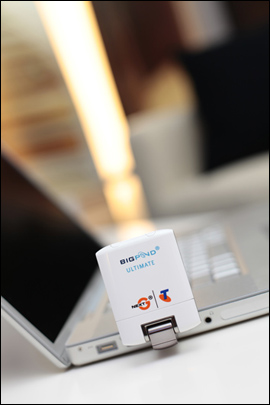Telstra today started selling its upgraded mobile broadband modem to the wider consumer market, after several months of offering the device — and its theoretical network speeds of up to 42Mbps — to big business customers and the government sector.
The telco’s Ultimate modem is — on paper — up to twice as fast as Telstra’s existing USB modem. However, customers will need to be in a coverage area which supports the increased speeds through the High-Speed Packet Access (HSPA+) specification the device uses.
So far, those areas are limited to capital city central business districts, as well as some airports, “selected metropolitan hubs” and more than 100 regional centres. Typical download speeds in those areas will range from 1.1Mbps to 20Mbps — comparable to speeds offered through ADSL2+ broadband.
Telstra will offer the Ultimate USB modem for zero dollars upfront on a number of mobile broadband plans on a 24-month contract. Its statement today did not disclose what it would sell the modem for outright, but it has previously stated the upfront cost as $299.
The telco has a range of plans with varying amounts of data, from $29.95 per month for 400MB of included quota, to $39.95 per month with 3GB included. It has also introduced two new plans today — a $59.95 plan with 7GB of data, and a $89.95 plan with 12GB of data included.
And that’s not all the telco is planning for its Next G network.
Telstra has previously said it was planning to again double its peak network speeds from 42Mbps to 84Mbps in 2011, through the implementation of the HDPA+ Dual Carrier plus MIMO (multiple input, multiple output) technology.
The next step after that will be the introduction of Long Term Evolution (LTE) technology, which rival carriers such as Optus are also planning.
Image credit: Telstra


The testing done at Dubbo I believe it was only showed a maximum of 6mbps REAL WORLD SPEED when used by reviewers of the Telstra 42mbps NextG service.
Nothing more than wank factor to try and make NexG sound better than it really is.
Well, even Telstra is being realistic about this one — they’re not hyping it up too much, as they know that there are only very small geographic areas where the tower upgrades have been deployed. I think they will get more aggressive about their marketing as time goes on and more areas get upgraded, and more devices come out that are capable of the enhanced speeds.
Having said all that, the difference between Telstra’s network and those of Optus + VHA is only getting starker every day. One wonders at what point SingTel or Vodafone HQ internationally decides that enough is enough and they’re going to throw down some real cash on the networks.
@Jason
Shows how wireless networks are unable to supply consistent speeds…
I would like to see this modem to be shown by Telstra doing a speed even close to 42Mbps because I bet it cant. They should give customers data on what speeds real world people get in various geographical locations so the can see before they sign up to Telstras notorious 24 month contracts and find out they are getting less than 4.2mbps. Why doesnt someone bring back a Chello style broadband service? Chello used to use a dialup modem used to request the data and a nice fat wifi downlink from a near by tower and it worked pretty darn nicely. And for the time it was amazingly fast. But there is nothing stopping an ADSL LONG HAUL/WIFI hibrid to get a decent uplink as well? Oh, except Telstra. It would be a top idea for those out west who live miles apart.
VividWireless is already reliably delivering real world speeds of 6 to 9 MBPS over its WiMAX (“4G”) network at much lower prices with no 24 month lock-in, and no “42 MBPS” spin.
Second matter: I just don’t see the attraction of signing up for Telstra’s 24 month 400 MB/month high speed plan at a cost of $29.95/month on a fast connection. Any power user would rip through such a low monthly quota within minutes.
Vivid’s use of the term “4G” is extremely misleading.
The 4G spec is firstly not even fully ratified, and secondly, of the details confirmed as targets for the spec, it needs to be at least 100Mbps to be “4G”. WiMAX is actually defined as “pre-4G”…I wish Vivid would stop using the term…
For real world sampling I did with this modem in Sydney, see this link on Whirlpool:
http://whrl.pl/Rct6i6
Average download speed: 7.92Mbps
Average Upload speed: 1.74Mbps
Average ping: 80.28ms
Sample size: 18 from Sydney CBD to south western Sydney
Telstra offered it’s take on “real world” performance here http://whrl.pl/RcvhlO
It didn’t take long for the “real world” analysis to be linked back to Telstra http://whrl.pl/Rcvhpd
Can we trust anything Telstra says?
We tested one of these at our office in Newcastle a couple of weeks ago, got a real world speed of 12Mbps on speedtest.net etc. Pretty good!
Max 42Mbps or 1.1Mbps to 20Mbps – great, go wireless – its the future – NOT.
This I think is crucial for boosting the mobile broadband market as it is crucial for people whom want to use broadband on the go every day when they go to cafe’s and other area’s such as parks as it is going ot become a bigger thing but I would suggest that telstra should start getting this intergrated into the building of laptops and desktops as it would boost the range in which they have with getting more customers involved in using the network of Telstra and therefore boosting the profit in which they make.
This a good product I think
I have been fortunate enough to have tested the 42Mbps Ultimate wireless card. I have posted my thoughts here:
http://notanalog.com/post/1523997645/telstra-42mbps-wireless-card-review-telstra-have
Comments are closed.